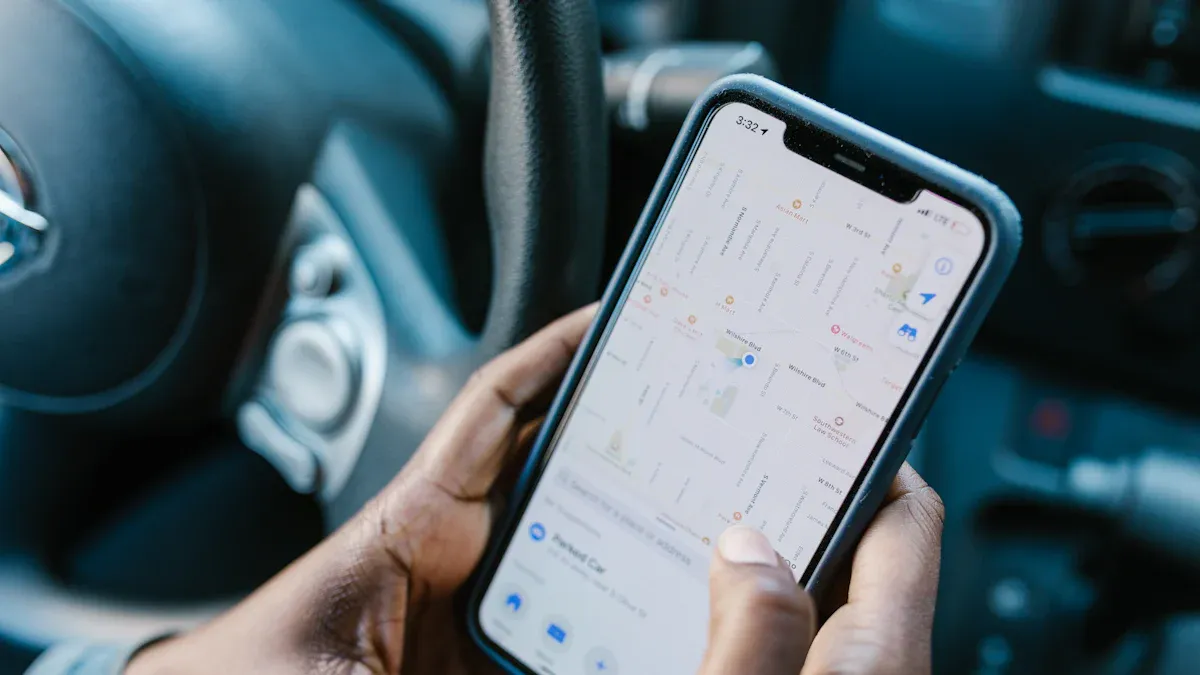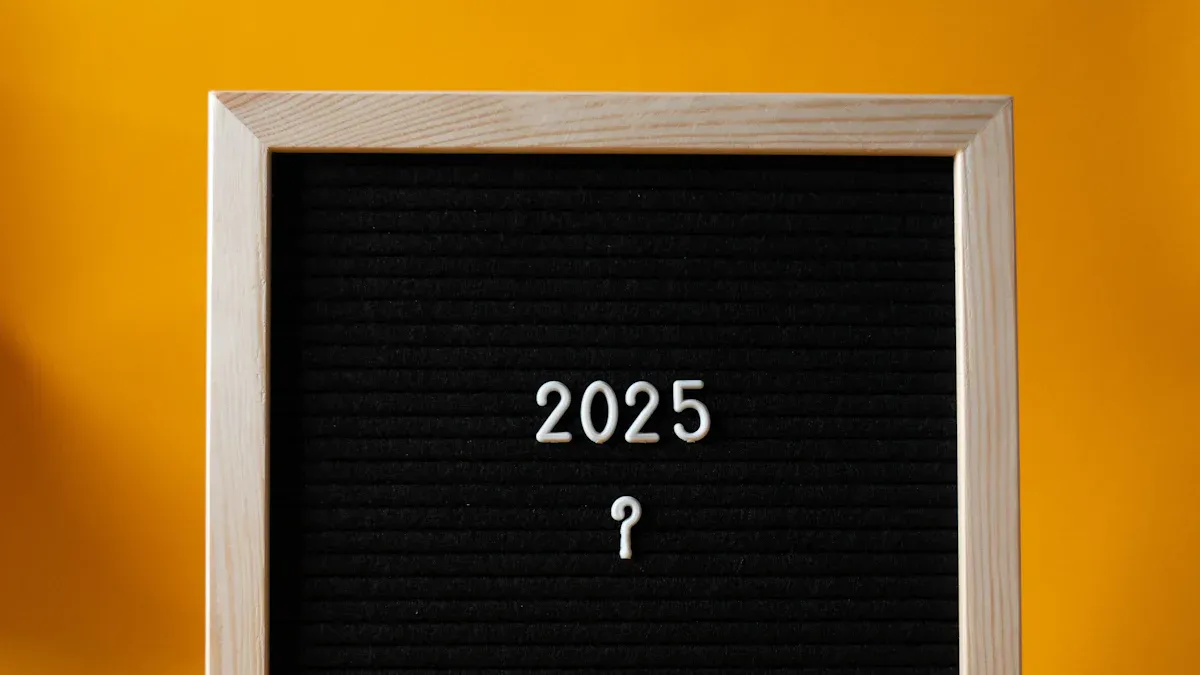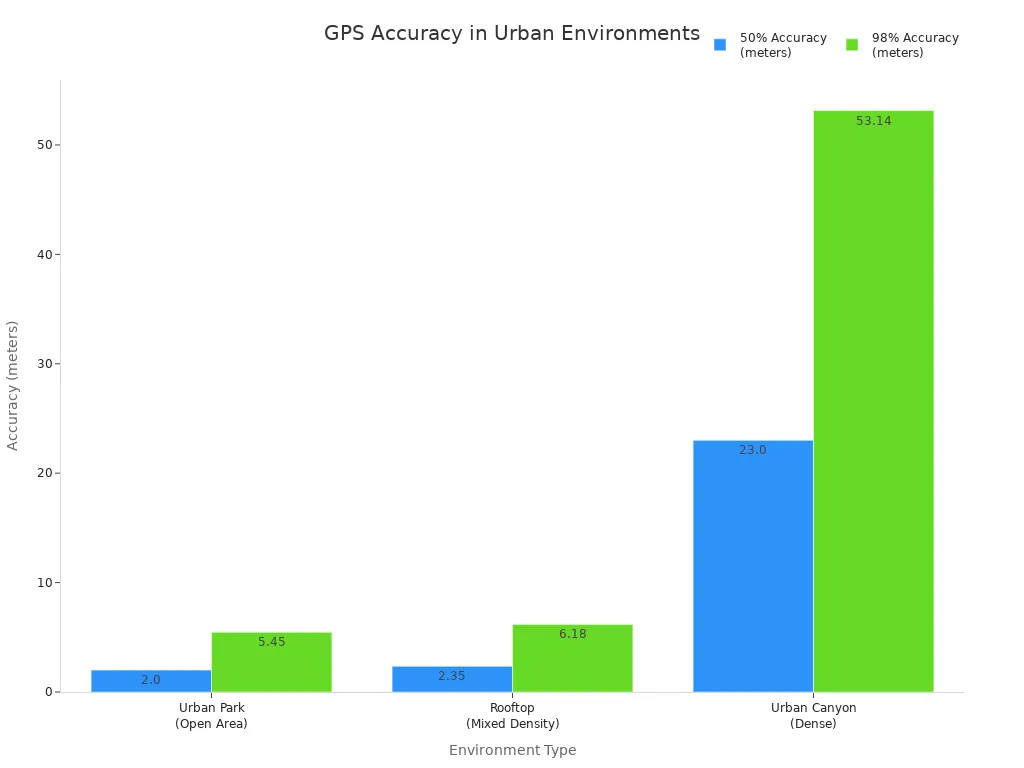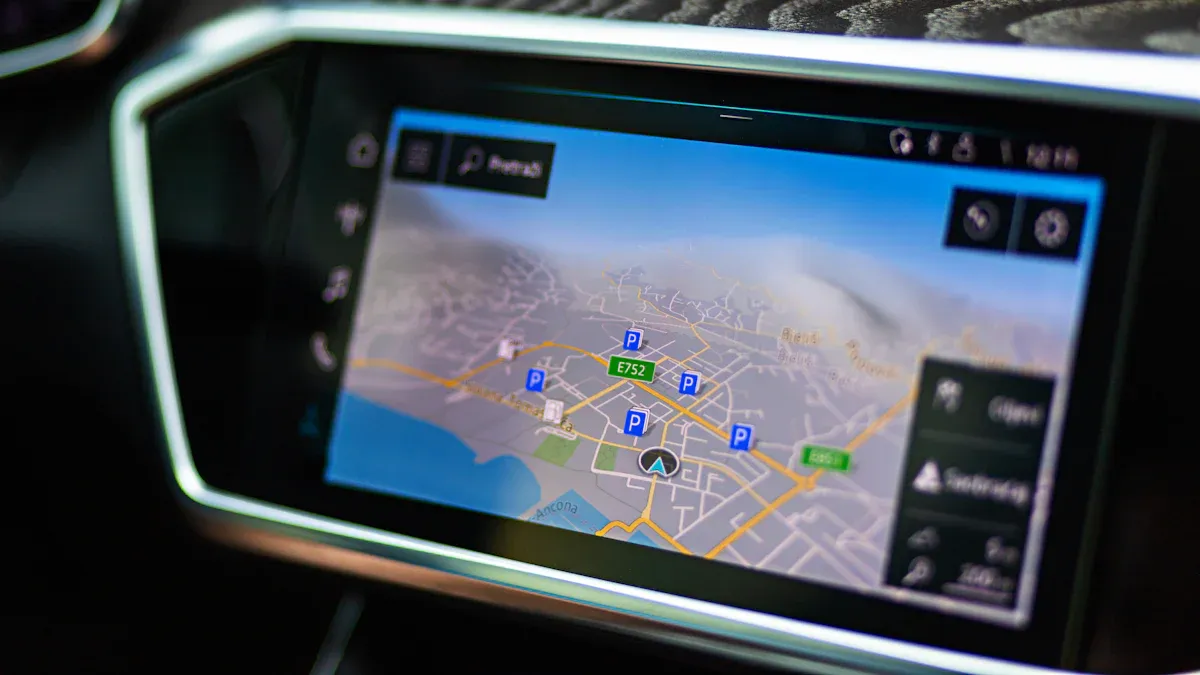
You see gps-based automatic advertising displays almost everywhere in 2025. These displays use gps signals to know your location very well. Geofencing creates invisible lines around places like stores or stadiums. When you walk into or leave these areas, the system shows ads made just for you. With gps and geofencing, businesses can send ads that fit your likes, the time, the weather, and what you bought before. This kind of targeting makes ads more personal and works better. You see these ads on your phone, in stores, or on digital signs as you go to different places.
Key Takeaways
GPS-based advertising shows you ads based on your location and interests. It picks ads that match where you are and what you like.
Geofencing sets up invisible lines around places. When you go in or out, it can show you special ads.
Digital signs and mobile screens switch ads right away using GPS, 5G, and programmatic delivery.
Personalized ads help you shop easier and make it more fun. They also help businesses sell more things.
Privacy is important. Companies keep your data safe and let you choose if you want to share your location for ads.
GPS-Based Automatic Advertising Display Technology

GPS Modules and Location Tracking
You use gps-based automatic advertising displays every day. These systems have gps modules that find your location very well. In open city parks, gps can find you within 2 or 3 meters. The table below shows how well gps works in different city places:
Environment Type | 50% Accuracy (meters) | 98% Accuracy (meters) | Average Distance from True Location (meters) |
|---|---|---|---|
Urban Park (Open Area) | ~2.00 | ~5.45 | ~2.82 |
Rooftop (Mixed Density) | ~2.35 | ~6.18 | N/A |
Urban Canyon (Dense) | ~23.0 | ~53.14 | N/A |

New gps modules are better and use less battery. You get live location data, so digital signs can show the right ads at the right time. These modules can also remember where you went and how fast you moved. This makes ads based on your location work better.
Geofencing and Geofencing Marketing
Geofencing makes invisible lines around real places. When you cross a geofence, you get ads or messages on your phone or on signs nearby. Geofencing marketing uses gps to know where you are and send you content right away. Businesses use geofencing to count how many people visit and how long they stay. This helps them make better ads. Geofencing marketing can also use Bluetooth beacons and RFID for even better targeting.
Geofencing marketing puts up digital borders for signs.
If you go in or out of a geofence, you get special ads.
GPS helps make sure ads reach the right people.
Display Hardware and Connectivity
Digital signs have screens, control boxes, and ways to connect. You see these signs in stores, cars, and public places. 5G and Wi-Fi help signs change ads quickly. 5G is fast and has little delay, so it is good for fun and changing ads. Signs can show different ads based on where you are, the time, or the weather. Programmatic ad delivery lets businesses swap ads fast, so messages stay new and interesting.
Tip: Good connections and correct location data make gps-based automatic advertising displays great for digital marketing.
How Location Based GPS Advertisement Works

Real-Time Data Capture
You use digital advertising displays almost every day. These displays find your location right away. The system gets GPS coordinates from your phone. It also uses Wi-Fi and Bluetooth to be more exact. Here is how it works step by step:
The system finds your location with GPS and other sensors.
It makes a geofence using longitude and latitude. This geofence is the target area for ads.
When you go in or out of a geofence, the system gets a signal.
The system uses a media buying platform to pick the best ad space.
It makes digital content like banners or coupons for you.
The system checks how you react to the ads. It looks at clicks, conversions, and how new the data is.
The system uses this info to make future ads better.
Note: Real-time data capture helps digital displays show you ads that fit your location and what you like. This makes location-based ads work better.
Ad Triggering and Selection
You notice ads change as you move to new places. The system uses geofencing to do this. Marketers set up geofences around stores, parks, or other spots. When you cross a geofence, the system checks your spot and picks what to show.
The system gets your location, including latitude and longitude.
Smart algorithms use this data to find your exact place.
Marketers use geofencing to make digital borders around real places.
When you enter or leave a geofence, the system shows a special ad.
The ad you see depends on where you are, where you have been, and what you like.
You may get notifications, offers, or deals that match your spot.
The system checks how you react to the ads to see what works best.
Geofencing marketing uses these steps to send you ads that fit your location. For example, if you walk by a coffee shop, the system can send you a coupon. This helps stores get more people inside and sell more. You get ads that feel personal and on time.
Programmatic Ad Delivery
You see programmatic ad delivery when you get ads that fit you. The system uses real-time data and geofencing to do this by itself. Programmatic platforms buy ad space and show you ads based on your spot.
The system connects to demand side platforms (DSPs) to buy ad space.
It uses your real-time spot to pick which ad to show.
The ad can be a banner, video, or something you can click.
The system changes the ad fast as you move between geofences.
It checks things like cost per click and conversions to see how well ads work.
The system uses this info to make future ads better.
Tip: Programmatic ad delivery makes digital ads faster and smarter. You see ads that fit your spot, the time, and even the weather.
With location-based GPS ads, you see digital content that changes as you move. Geofencing, real-time data capture, and programmatic ad delivery work together. They help you get the best ads wherever you go.
Targeted Advertising in Action
Moving Vehicles and Mobile Displays
You see targeted ads when you pass cars with screens. These screens use geofencing and GPS to show messages in different places. When a car enters a geofence, the screen changes to match the area. You get ads that fit your neighborhood, the time, and the weather.
Mobile screens use geofencing to change ads right away.
Programmatic marketing lets companies buy ad space as cars move.
You get ads that match what you like and where you are.
Car screens can show ads based on age, weather, or time.
These screens count how many people see them and help stores sell more.
Mobile screens work better than signs that never change. You see new ads that matter to you. Using both types of signs helps people see ads for a long time and also get special messages. This makes ads stronger and helps businesses do better.
Retail and Public Spaces
You see targeted ads in stores and public places with digital screens. These screens use geofencing to send messages as you move around. The ads change based on where you are, the time, and the weather.
Store screens use geofencing to show ads that match what you do.
Some screens let you answer polls or scan QR codes to join in.
Digital screens help you find fun places, events, or news.
Stores use geofencing to send you special ads and make shopping better.
You see ads at doors and checkouts, which makes you buy more.
Screens collect info about what shoppers do to help stores improve.
Studies say these screens can help stores sell up to 30% more.
Retailer | Strategy Using GPS/Location-Based Digital Displays | Outcome/Impact |
|---|---|---|
Shows special ads and deals in busy spots using screens and location data. | More people buy things and pay attention. | |
Sephora | Has screens with try-on tools and deals based on where you are. | Shoppers are happier and buy more. |
Nike | Uses screens with feedback and geofencing to show ads and get ideas from shoppers. | People join in more and sales go up. |
Note: Using digital screens and geofencing makes shopping better for you and helps stores reach their goals.
Benefits and Challenges
Enhanced Targeting and Engagement
Geofencing and geofence technology make digital marketing better in 2025. Digital signage and geofencing show you content that fits where you are and what you like. Businesses use personalisation so you see digital content that matches your needs. When you walk by a store, digital signage can show you deals or events just for you. This makes you feel special and helps you find things faster.
Geofencing gives you digital content based on your exact spot.
Personalisation means you see digital signage with offers for you.
Personalised messaging makes you more interested and want to visit stores.
Businesses use geofencing to send content about local trends and events.
You get digital content at the right time, like lunch deals near restaurants.
Geofencing helps marketing teams reach people ready to buy.
Digital signage with geofencing gives you real-time updates and new content.
Personalisation and personalised messaging help you feel close to brands.
You see digital content that changes as you move, making things better.
Good geofencing leads to more sales and happier customers.
You help businesses get better at marketing when you react to digital signage and content. Companies use your feedback to improve their geofencing plans.
Privacy and Compliance
You care about privacy when you see digital signage and get personalised messaging. Businesses must follow rules to keep your location data safe. They use secure systems to protect your information. You always get a clear notice about how your data is used for geofencing and personalisation. You can choose to share your location or not for digital marketing.
Description | Typical Solution | |
|---|---|---|
Privacy Concerns and Data Security | You worry about sharing your location for digital signage and marketing. | Companies use strong security and follow laws to build trust. |
Technical Complexities | Some teams find geofencing and digital signage hard to manage. | Training and new tools help teams use geofencing and personalisation better. |
User Experience and Engagement | You want digital content and personalised messaging that match your needs. | Businesses use feedback to improve geofencing and digital signage campaigns. |
Exposure Limitations | Some areas do not get enough digital signage or content. | Companies plan geofencing to reach more customers with digital marketing. |
Bridging the Dealer-Customer Gap | You want easy ways to talk to brands through digital signage and geofencing. | Geofencing helps create better connections with personalised messaging. |
Safeguarding Brand Image | Brands want digital content and marketing to match their values. | Teams watch campaigns to keep digital signage and geofencing on track. |
Converting Leads into Conversions | Turning interest from digital signage into real sales can be hard. | Data from geofencing and personalisation helps improve marketing results. |
You see that good geofencing needs trust. Businesses must use digital signage and geofencing in ways that respect your choices. They follow laws and use clear personalisation rules. This keeps your location and personal data safe while giving you better digital content and personalised messaging.
You can get digital content that fits what you need because of geofencing and real-time location data. Businesses use digital signage and geofencing to send you messages when you are in the right spot. When you choose a technology partner, make sure they have good location data, strong privacy rules, and help with digital content. Geofencing helps you reach people with content that matches where they are and what they like. Keep learning about new digital trends like AI and 5G so your content stays new and your customers stay interested. Using geofencing and digital signage helps you earn trust and give people content that matters to them.
FAQ
How do GPS-based advertising displays know my location?
GPS modules in your phone or nearby devices send your location to the system. The system uses this data to show you ads that match where you are. You always control if you share your location.
Can I turn off location-based ads?
Yes, you can turn off location sharing in your device settings. Most apps and displays ask for your permission before using your location. You decide when and how to share your data.
Are my personal details safe with these displays?
Companies use strong security to protect your data. They follow privacy laws and give you clear choices. You can read privacy policies to learn how your information stays safe.
Where do I see GPS-based ads most often?
You see these ads in:
Shopping malls
Public transport stations
Moving vehicles
Store entrances
These places use digital screens to show you ads that fit your location.
See Also
Why AI Box CarPlay Will Be Essential In 2025
Best Wireless Android Auto Adapters Reviewed For 2025
Leading CarPlay To HDMI Dongles Supporting 4K In 2025
Best Motorcycle GPS Units Featuring CarPlay And Android Auto
